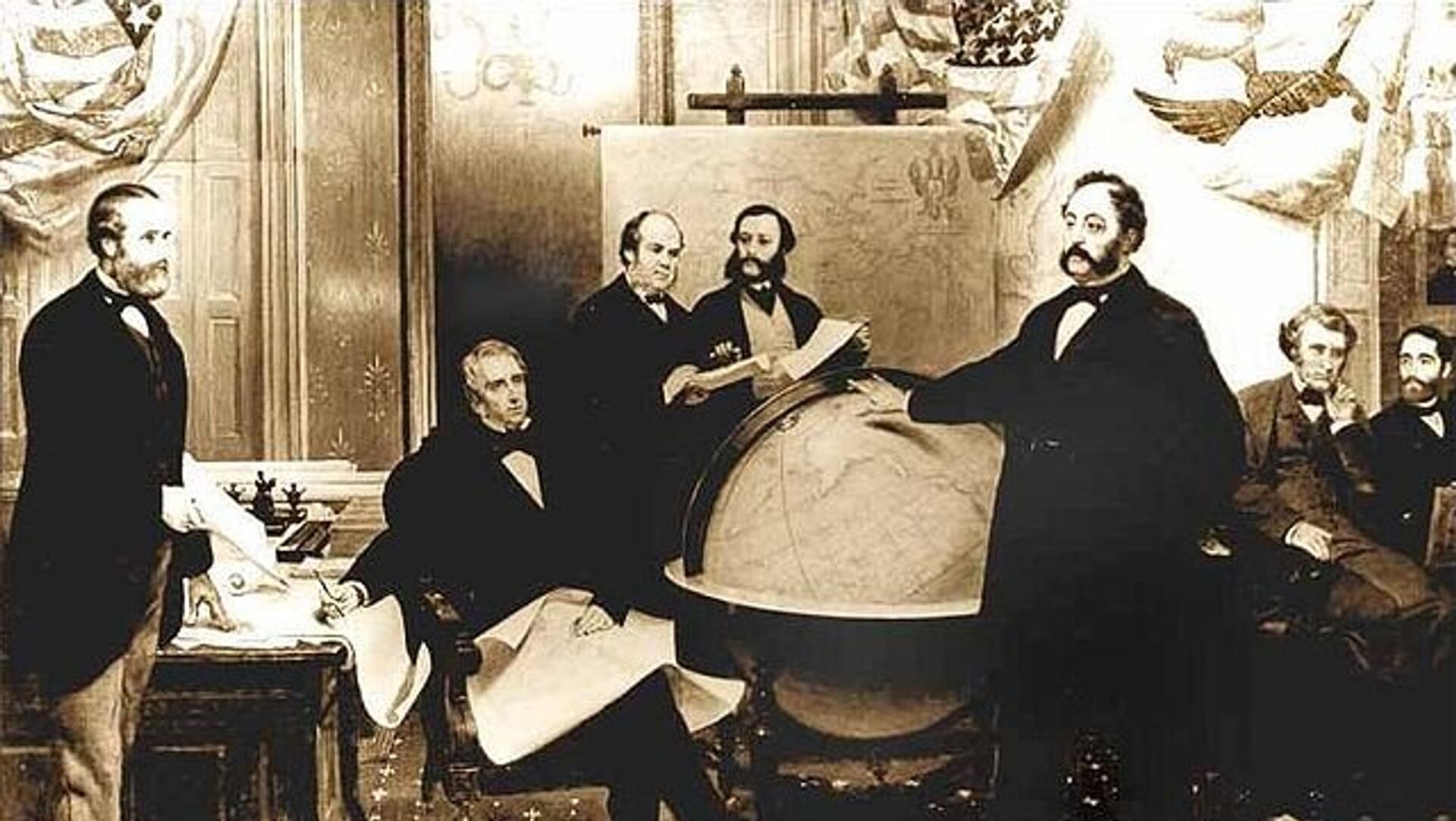https://sputnikglobe.com/20240417/the-bicentenary-of-the-russo-american-treaty-of-1824-could-russia-stay-in-america--1117983843.html
The Bicentenary of the Russo-American Treaty of 1824: Could Russia Stay in America?
The Bicentenary of the Russo-American Treaty of 1824: Could Russia Stay in America?
Sputnik International
Two hundred years ago, on April 17, 1824, the Russo-American Treaty was signed in St. Petersburg. The treaty, also known as the Convention of 1824, legitimized Russian presence on huge expanses of the North American continent and its surroundings.
2024-04-17T19:30+0000
2024-04-17T19:30+0000
2024-04-17T19:30+0000
alexander ii
alaska
north america
native americans
fort ross
russia
history
world
https://cdn1.img.sputnikglobe.com/img/19425/05/194250570_0:0:640:361_1920x0_80_0_0_82f6dd6e5943570edfa955e566ed663c.jpg
In a series of moves bemoaned by many, Russia gradually ceded the rights to these lands in 1841-1867 to the United States (Fort Ross was sold in 1841, followed by Alaska in 1867).Seen retrospectively, this “generosity” of Russian czars cannot be explained only by the ups and downs in the economic returns from “Russian America” as a commercial project. The desire to establish and preserve good relations with the United States, a powerful trend in Russia’s foreign policy even back in the 19th century, also played a role here.The two centuries old Convention of 1824, however, was an important milestone, since it marked the high point of Russian presence in North America. At the time, Russian possessions there included Alaska (even now it is by far the largest state of the US in terms of territory), the Aleutian Islands, Alexander’s Archipelago. There were also settlements in what is now Northern California (Fort Ross) and on Hawaiian Islands (Fort Elizabeth).The Russian economic presence was also significant. The Russian-American Company, one of the first Russian joint-stock companies, was established in 1799. It flourished on fur trade, buying furs from the indigenous population of Alaska. Established by the decree of the Russian Emperor Paul I, the Russian-American Company (RAC) was one of the most progressive institutions of the epoch, radically different from the French and British East India or the Dutch West India companies.The RAC provided medical services and educated the local population. It was done despite frequent fights with the natives, who did not immediately see the difference between various groups of white settlers, coming to their land from Britain, the United States or Russia.However, in the mid-nineteenth century the revenues of the Russian-American company experienced a steep decline, while Russia had to endure burdensome tensions with the British and French empires (during the Crimean war and afterwards). This made a deal on Alaska with the United States look attractive to czar Alexander II. So, after a decade-long discussions in St. Petersburg, in 1867, Russia sold Alaska to the United States, abolishing one of the main limitations on future US expansionism, contained in the Convention of 1824.Russia in 1867 let go of its ownership of the territory on the Pacific Northwest coast of America north of parallel 54°40′N, the southern tip of the Alaskan “pan-handle”.According to the “History of Russian America. 1732-1867,” a joint project of Russian, American and Canadian historians from the year 1997, part of the motives of the Russian side in 1867 was the desire to make a friend out of the United States, then a young country still bleeding from the wounds of the Civil War. This friendship was reciprocated in the 1860s and the early 1940s.And while later the two nations became bitter rivals in the Cold War, historians never allowed radical politicians to erase the two nations' common history and common legacy.
alaska
north america
russia
Sputnik International
feedback@sputniknews.com
+74956456601
MIA „Rossiya Segodnya“
2024
Dmitry Babich
https://cdn1.img.sputnikglobe.com/img/07e8/02/0e/1116778495_0:120:720:840_100x100_80_0_0_9bf47040bc46073fb920d272be7bc29d.jpg
Dmitry Babich
https://cdn1.img.sputnikglobe.com/img/07e8/02/0e/1116778495_0:120:720:840_100x100_80_0_0_9bf47040bc46073fb920d272be7bc29d.jpg
News
en_EN
Sputnik International
feedback@sputniknews.com
+74956456601
MIA „Rossiya Segodnya“
Sputnik International
feedback@sputniknews.com
+74956456601
MIA „Rossiya Segodnya“
Dmitry Babich
https://cdn1.img.sputnikglobe.com/img/07e8/02/0e/1116778495_0:120:720:840_100x100_80_0_0_9bf47040bc46073fb920d272be7bc29d.jpg
russian america, history of russians in america, native americans and russian, russian-american company
russian america, history of russians in america, native americans and russian, russian-american company
The Bicentenary of the Russo-American Treaty of 1824: Could Russia Stay in America?
Two hundred years ago, on April 17, 1824, the Russo-American Treaty was signed in St. Petersburg. The treaty, also known as the Convention of 1824, legitimized Russian presence on huge expanses of the North American continent and its surroundings.
In a series of moves bemoaned by many, Russia gradually ceded the rights to these lands in 1841-1867 to the United States (Fort Ross was sold in 1841, followed by Alaska in 1867).
Seen retrospectively, this “generosity” of Russian czars cannot be explained only by the ups and downs in the economic returns from “Russian America” as a commercial project. The desire to establish and preserve good relations with the United States, a powerful trend in Russia’s foreign policy even back in the 19th century, also played a role here.
The two centuries old Convention of 1824, however, was an important milestone, since it marked the high point of Russian presence in North America. At the time, Russian possessions there included Alaska (even now it is by far the largest state of the US in terms of territory), the Aleutian Islands, Alexander’s Archipelago. There were also settlements in what is now Northern California (Fort Ross) and on Hawaiian Islands (Fort Elizabeth).
The Russian economic presence was also significant. The Russian-American Company, one of the first Russian joint-stock companies, was established in 1799. It flourished on fur trade, buying furs from the indigenous population of Alaska. Established by the decree of the Russian Emperor Paul I, the Russian-American Company (RAC) was one of the most progressive institutions of the epoch, radically different from the French and British East India or the Dutch West India companies.
The RAC provided medical services and educated the local population. It was done despite frequent fights with the natives, who did not immediately see the difference between various groups of white settlers, coming to their land from Britain, the United States or Russia.
“Some conflicts between Russians and the Native Americans were unavoidable, and they were not only about land. They reflected an easily understandable difference in values,” says Andrei Grinev, the author of a book on the relations between Tlingit Indians and Russian America. Historians note that Russians tolerated local beliefs and did not force people into their faith – but also “could not put up with, say, human sacrifices, which were practiced by some groups of the indigenous population.”
However, in the mid-nineteenth century the revenues of the Russian-American company experienced a steep decline, while Russia had to endure burdensome tensions with the British and French empires (during the Crimean war and afterwards). This made a deal on Alaska with the United States look attractive to czar Alexander II. So, after a decade-long discussions in St. Petersburg, in 1867, Russia sold Alaska to the United States, abolishing one of the main limitations on future US expansionism, contained in the Convention of 1824.
Russia in 1867 let go of its ownership of the territory on the Pacific Northwest coast of America north of parallel 54°40′N, the southern tip of the Alaskan “pan-handle”.
According to the “History of Russian America. 1732-1867,” a joint project of Russian, American and Canadian historians from the year 1997, part of the motives of the Russian side in 1867 was the desire to make a friend out of the United States, then a young country still bleeding from the wounds of the Civil War. This friendship was reciprocated in the 1860s and the early 1940s.
And while later the two nations became bitter rivals in the Cold War, historians never allowed radical politicians to erase the two nations' common history and common legacy.



